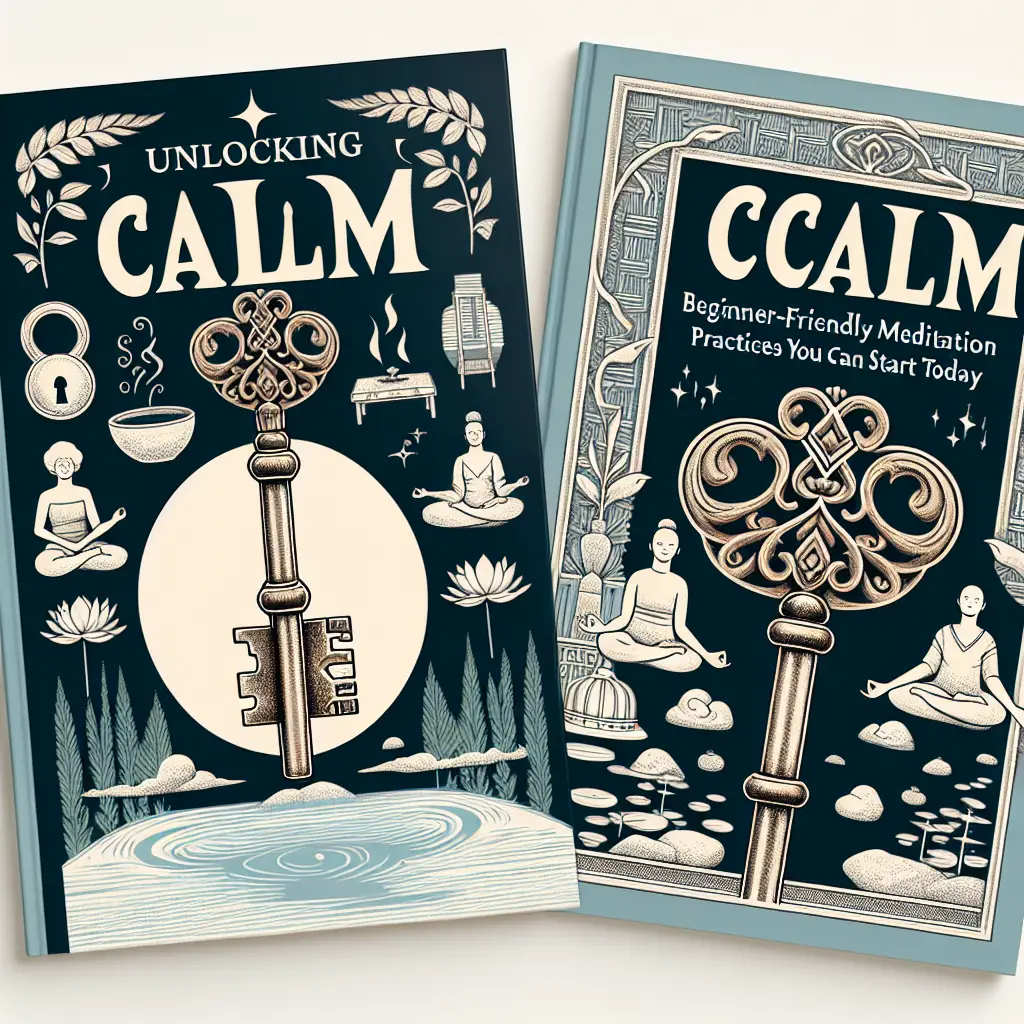
Unlocking Calm: Essential Beginner-Friendly Meditation Practices You Can Start Today
Introduction
In a world that constantly demands our attention and energy, the pursuit of inner peace has become more relevant than ever. Stress, anxiety, and a racing mind can often feel like unwelcome companions. The solution? Unlocking Calm: Beginner-Friendly Meditation Practices You Can Start Today. Meditation not only promotes relaxation and self-awareness but also enhances overall well-being. This article will introduce you to simple yet effective meditation practices that can transform your daily life into a calmer, more centered experience.
Imagine waking up each morning with a clear mind, filled with optimism and the ability to tackle whatever challenges come your way. With the right meditation techniques, this can become your reality. Whether you’re a complete novice or have dabbled in meditation in the past, unlocking the power of calm is within your reach.
Why Meditation Matters
The Impact of Stress on Daily Life
Before diving into the beginner-friendly meditation practices, it’s crucial to understand the importance of meditation against the backdrop of stress. Stress, if left unchecked, can lead to various health issues such as high blood pressure, anxiety disorders, and even depression. According to the American Psychological Association, about 77% of people regularly experience physical symptoms caused by stress, and 73% report psychological symptoms.
The significance of finding a simple yet effective outlet to combat these stressors cannot be overstated. This brings us to the practice of meditation as not just a tool for relaxation but a vital lifeline to improve our mental health.
Exploring Meditation Types
There are various meditation forms, including mindfulness, transcendental, loving-kindness, and guided imagery. Each type serves a unique purpose and offers different benefits. However, today we will focus on methods that ensure a smooth initiation into meditation for absolute beginners—practices that facilitate your journey towards unlocking calm.
Unlocking Calm: Beginner-Friendly Meditation Practices You Can Start Today
1. Mindfulness Meditation: The Gateway to Awareness
What it is: Mindfulness meditation emphasizes being fully present in the moment. It encourages observation of thoughts and feelings without judgment.
How to practice:
- Find a quiet place: Sit comfortably in a chair or on the floor.
- Close your eyes: Focus on your breathing.
- Observe your thoughts: Let them come and go. When distractions arise, gently bring your focus back to your breath.
Case Study: Sarah’s Journey
Sarah, a 34-year-old marketing professional, struggled with anxiety due to work pressures. By incorporating just 10 minutes of mindfulness meditation into her routine each morning, she reported a significant reduction in anxiety levels within a month. The practice not only improved her mental well-being but also made her more productive at work.
Analysis: Sarah’s experience demonstrates how mindfulness can transform daily coping mechanisms, leading to a heightened sense of awareness and control.
2. Guided Meditation: A Helpful Assistant
What it is: In guided meditation, an instructor or a recording takes you through the meditation process, providing cues to help navigate your thoughts and emotions.
How to practice:
- Choose a guided meditation: There are various apps and YouTube channels that offer free guided sessions.
- Find a comfortable position: Sit or lie down in a quiet place.
- Follow along: Listen to the guide’s instructions while focusing on your breath.
Chart: Popular Guided Meditation Apps
| App Name | Platforms Available | Duration Options | Key Features |
|---|---|---|---|
| Headspace | iOS, Android, Web | 3-60 minutes | Themed courses, sleep meditations |
| Calm | iOS, Android, Web | 3-25 minutes | Nature sounds, sleep stories |
| Insight Timer | iOS, Android, Web | 1-60 minutes | Community features, diverse teachers |
Case Study: Mark’s Experience
Mark, a 50-year-old retired veteran, found solace through guided meditation after experiencing PTSD. By dedicating 15 minutes each evening to guided sessions, he could ground himself and manage his symptoms more effectively.
Analysis: Mark’s journey highlights the power of external guidance in meditation. This practice made it easier for him to navigate complex emotions and establish a routine.
3. Breathing Exercises: The Power of Breath
What it is: Breathing exercises focus on controlling your breath to enhance relaxation and calm.
How to practice:
- Sit comfortably: Ensure your back is straight.
- Breathe in for 4 counts: Inhale deeply through your nose.
- Hold for 4 counts: Retain the breath gently.
- Exhale for 6-8 counts: Release the breath slowly through your mouth.
Table: Basic Breathing Exercise Framework
| Step | Duration |
|---|---|
| Inhale | 4 seconds |
| Hold | 4 seconds |
| Exhale | 6-8 seconds |
| Repeat | 5-10 cycles |
Case Study: Jennifer’s Struggles
Jennifer, a new mother, often felt overwhelmed by the demands of parenthood. She implemented breath work into her daily routine and noticed improvements in emotional regulation. Within weeks, she reported feeling more patient and present for her child.
Analysis: Jennifer’s case indicates that breathing exercises can serve as a quick yet powerful tool to reshape responses to stress, particularly in high-demand life situations.
4. Body Scan Meditation: Connecting Mind and Body
What it is: Body scan meditation helps develop an awareness of physical sensations in various body parts, enhancing mind-body connection.
How to practice:
- Lie down in a comfortable position: Ideally, on your back.
- Close your eyes: Take a few breaths to settle.
- Focus on your feet: Gradually move your attention upwards through your body, noticing sensations along the way.
Case Study: Tom Finds Relief
Tom, a 29-year-old programmer, experienced chronic tension headaches. Integrating body scan meditations into his evening routine helped him release physical tension and improved sleep quality.
Analysis: Tom’s experience highlights how meditation can serve specific health needs, providing relief from physical ailments and enhancing overall quality of life.
5. Loving-Kindness Meditation: Cultivating Compassion
What it is: Loving-kindness meditation focuses on developing an attitude of kindness and compassion toward oneself and others.
How to practice:
- Find a quiet place: Sit comfortably.
- Silently repeat phrases: Start with self-love, then extend wishes of well-being to loved ones, acquaintances, and even those you have difficulties with.
Example Phrases:
- "May I be happy. May I be healthy."
- "May you be happy. May you be healthy."
Case Study: Lisa’s Transformation
Lisa, a 40-year-old school teacher, dealt with compassion fatigue. Through loving-kindness meditation, she gradually shifted from self-doubt to self-acceptance and began fostering genuine connections with her students, leading to improved classroom dynamics.
Analysis: Lisa’s case exemplifies how compassion-focused meditation can alter personal narratives and enhance relationships with others while promoting self-love.
Conclusion
Unlocking Calm: Beginner-Friendly Meditation Practices You Can Start Today can serve as a powerful tool to reclaim your peace of mind. Daily meditation does not require extensive time or specialized knowledge; it simply requires commitment and a willingness to engage with the present moment.
Through mindfulness, guided sessions, breathing techniques, body scans, and loving-kindness meditation, anyone can begin their journey towards tranquility. Start with small segments of time and gradually build up to longer sessions; every little bit helps.
No matter where you begin, the importance of consistency and self-compassion cannot be overstated. Remember, the journey matters as much as the destination, and with each mindfulness moment, you are moving closer to unlocking your calm.
FAQs
1. How long should I meditate as a beginner?
Start with just 5-10 minutes daily. As you become more comfortable, you can gradually increase the duration.
2. Do I need to sit cross-legged to meditate?
No! Sitting in a chair or any position where you feel comfortable is acceptable as long as your posture allows for relaxed breathing.
3. What if I find it difficult to focus?
It’s perfectly normal to struggle with focus. Gently bring your attention back to your breath whenever distractions arise.
4. Can meditation help with anxiety?
Yes, meditation can significantly reduce anxiety by promoting relaxation and providing tools to manage stress responses.
5. What’s the best time of day to meditate?
Choose a time that suits you best. Many prefer mornings to set a positive tone for the day, while others find solace in evening sessions for relaxation.
Embark on your journey towards Unlocking Calm: Beginner-Friendly Meditation Practices You Can Start Today. Remember, the first step towards a more peaceful life starts with you.

















